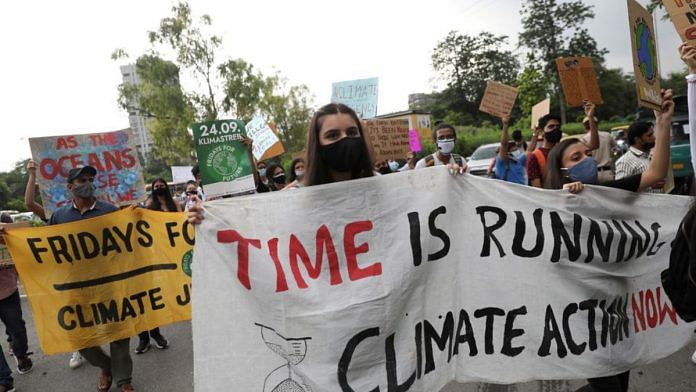Click into any social media app and it won’t be long until you are confronted with firmly entrenched opinions on a whole range of topics. We live in an increasingly polarized world where subjects from reality TV to geopolitics can prove bitterly divisive.
When it comes to climate change, people tend to be classified in a strictly binary way: you are either a climate believer or a climate denier. Nuance, it would seem, is for the birds.
Climate scientist and author Katharine Hayhoe sees it differently.
Speaking to the World Economic Forum’s Radio Davos podcast, for an episode entitled How to Talk to a Climate Change Sceptic, Hayhoe says the “believer” and “denier” labels are too simplistic and there is a spectrum of beliefs on climate change.
“The word denier is often applied to people who have questions, who aren’t sure, who have heard things from people they trust, and they’re not sure who to believe,” says Hayhoe.
“Rather than just two categories, I prefer what’s called the six categories that the Yale Program on Climate Communication has developed.”
The six psychological responses to climate change
Hayhoe says that to communicate effectively with people who may be sceptical, it’s important to understand which of the six categories they fit into. Let’s take a look.
Alarmed: These people believe climate change is happening and that human activity is the cause of it. They are supportive of strong political and social action to tackle it.
Concerned: They believe in climate change driven by humans but think the consequences lie far into the future. For this reason they deprioritize it as an issue.
Cautious: This group are still to make up their minds on climate change. They have questions on the existence, cause and consequences of a changing climate.

Beliefs on climate change fall into six categories spanning alarmed to dismissive. Image: Yale Program on Climate Communication
Disengaged: This group knows very little about global warming and are not exposed to the issue in the media.
Doubtful: This group doesn’t believe climate change is happening or that it is part of the Earth’s normal cycle that poses little risk. Hayhoe says these people are often doubtful because they have heard that solutions pose a threat to their identity, to their well-being, to their ideology.
Dismissive: Most in this group believe conspiracy theories that suggest global warming is a hoax. They see no threat from an issue they don’t believe in.
Most people now fall into the alarmed and concerned groups, believes Hayhoe, and they face challenges in communicating the urgency of tackling climate change to people in other groups, even when they are close friends and family.
Hayhoe’s advice on starting such conversations is to begin with something you hold in common and build from there. With “cautious” people she says be prepared for them to “lead with their doubts” and prepare good answers to their questions. These people are often dismissed as “deniers”, says Hayhoe, but they are open to the findings of serious science.
The most challenging group, says Hayhoe, are the “dismissive” who make up about 10% of the population in the United States and less in other countries.
This group, she says, are likely impossible to convince: “They will dismiss what 2,000 scientists have to say, they will dismiss what 2 million scientific studies have to say. They will dismiss anything and everything that they think may pose a threat to their identity and their ideology.”
Hayhoe has some straight-talking advice for communicating with relatives in this category. “My best advice is to say, I’m sorry, you’re wrong, and let’s talk about something else.”
Putting the science first
As an atmospheric scientist, Hayhoe is a great advocate of putting the evidence at the forefront of conversations on climate change. There is a mass of data on changing weather patterns, but extreme weather events are frequently becoming a lived experience rather than detached data.
“How could this be happening?” says Hayhoe. “How could we be having three 500-year flood events in three years? How could we be seeing wildfire events so extreme that half a continent is blanketed in orange smoke? How do we see not one or two, but eight record breaking floods around the world in the same week?”
It’s a phenomenon Hayhoe refers to as “global weirding” and people everywhere are becoming more aware of unusual and unnatural weather events and their frequently devastating consequences.
Data from the US National Oceanic and Atmospheric Administration (NOAA) backs up these observations of global weirding and the shrinking gap between extreme weather events that were once measured in decades or even centuries.

The period between extreme weather events is becoming shorter as the climate evolves. Image: Visual Capitalist/Planet Anomaly
The illustration above, based on data from the NOAA, shows the gap between weather events that cause more than a billion dollars worth of damage (adjusted for inflation) has narrowed.
In the 1980s the average gap between such events in the US was 75 days – in the 2020s it is now 18 days.
For many people, the scale of the challenge in tackling climate change leads us to question what difference we can possibly make as individuals. Hayhoe says speaking up to convince others of the urgency is critical.
“We can make a difference by using our voice to advocate for change wherever we are. Our voice is the most powerful force we have. That is how the world has changed before, and that is how the world can change again.”
Simon Torkington is Senior Writer, Forum Agenda
The article was first published in World Economic Forum. You can read the article here.
Also read: How oil companies put the responsibility for climate change on consumers



